| Home Page | New Data | Chronology | Cast Coins | Struck Coins | Paper Money | Links/Reference |
|
In 1661, The young Shun Chih Emperor caught smallpox and passed
away. His third son, Hsuan Yeh The coinage of the K'ang Hsi series is very interesting. Have
you heard about the K'ang Hsi Ch'ien Shih |
|
T'ung |
Fu |
Lin |
Tung |
Chiang, |
|
Hsuan |
Yuan |
Su |
Chi |
Ch'ang, |
|
Nan |
Ho |
Ning |
Kuang |
Che, |
|
T'ai |
Kuei |
Shen |
Yun |
Chang. |
Extremely Rare A ~ Very Rare B ~ Rare C ~ Not So Many D ~ Common E
| Obverse | Reverse | Description |
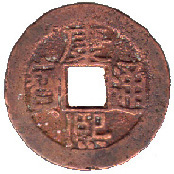
|
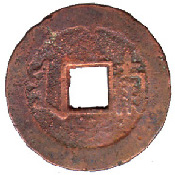
|
No. 0056 |
| Mint: Changsha | ||
| Diam. 24 mm | ||
| Wt. 3.0 g. | ||
| Rareness C | ||
| Mint Evolution and Peculiarity | ||
|
This coin was cast by the Changsha Mint of Hunan Province bearing
with the "Nan" mint marks written in both Manchu and
Han script When Hunan and Hupeh Provinces were split from Hukuang Province in the sixth year of the K'ang Hsi reign (1667), Changsha Mint of Hunan Province was established in the same year. Its cash are relatively rare and comparatively smaller in diameter. [Personally, I have seen two "Hunan K'anghsi T'ung Pao" only in Hong Kong for the past 10 years. It is rare really!] Hunan copper cash are very similar to those later cast in Kwangtung Province, in reddish appearance and lighter in weight. In 1683, another mint was established in Hunan Province. [But, I don't know where the new mint was situated. May be some more advanced collector can help me] In 1697, Hunan cash were forbidden to circulate in the market as they were too small and light. Actually, Hunan copper cash were still used in 1708. Hunan Mint was closed in 1700. |
||
| Obverse | Reverse | Description |
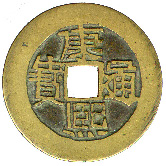
|
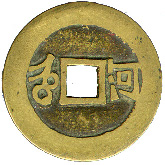
|
No. 0057 |
| Mint: Kaifeng | ||
| Diam. 27 mm | ||
| Wt. 3.4 g. | ||
| Rareness E | ||
| Mint Evolution and Peculiarity | ||
|
Kaifang Mint of Honan Province was established in the tenth year
of the Shun Chih reign (1653). In 1667, all the provincial mints
were reopened. Kaifang Mint cast the K'ang Hsi T'ung Pao again
with the "Ho" |
||
| Obverse | Reverse | Description |
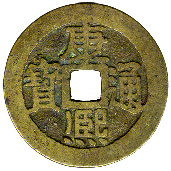
|
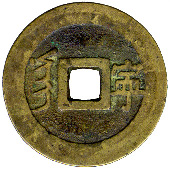
|
No. 0058 |
|
Mint: Kiangning or Ninghsia and or Ningpo ? |
||
| Diam. 27 mm | ||
| Wt. 4.9 g. | ||
| Rareness E | ||
| Mint Evolution and Peculiarity | ||
|
In the Qing Dynasty, the mint marks in both Chinese and Manchu
characters on the reverse of the coin are normally indicated
where the coin was cast. But the identifying character of this
coin, On the contrary, character Mr. Fr. Schjoth had wrote that "Ning" was used for Ningpo Mint in Chekiang Province in his book about Chinese currency. About the identifying character of this coin, |
||
| Obverse | Reverse | Description |
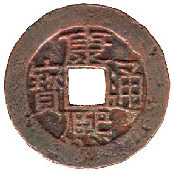
|
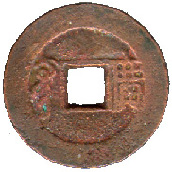
|
No. 0059 |
| Mint: Kwangchow | ||
| Diam. 24 mm | ||
| Wt. 3.3 g. | ||
| Rareness E | ||
| Mint Evolution and Peculiarity | ||
|
Kwangchow Mint (Canton) was first established in the 7th year
of K'ang Hsi reign (1668AD), for the casting of the cash coins
, each weighting 1.4 mace (rare now). On the reverse are mint
marks "Kuang" in both Manchu script and Han script |
||
| Obverse | Reverse | Description |
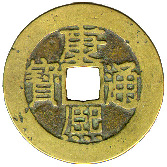
|
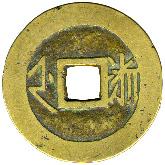
|
No. 0060 |
| Mint: Hangchow | ||
| Diam. 27 mm | ||
| Wt. 4.2 g. | ||
| Rareness E | ||
| Mint Evolution and Peculiarity | ||
|
Hangchow Mint of Chekiang Province was first established in the
6th year of Shun Chih reign (1649AD). After it terminated casting
coins in 1662, Hangchow Mint reopened to cast coins again in
1667. It cast coins of "K'ang Hsi T'ung Pao" bearing
with "Che" mint marks in both Han script It is very strange to me that some of the numismatic works pointed out, Chekiang coins are too small with a reddish appearance, similar to those of Hunan and Kwangtung. But I don't think so, at least what I have seen are the same as other standard cash of Qing dynasty. |
||